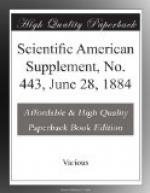In accordance with this theory, if we take a thermo-electric pair consisting of a non-corrodible metal and an electrolyte (the two being already electro-polar by mutual contact), and heat one of their points of contact, the molecular motions of the heated end of each substance at the junction are altered; and as thermo-electric energy in such combinations usually increases by rise of temperature, the metal and liquid, each singly, usually becomes more electro polar. In such a case the unequally heated metal behaves to some extent like two metals, and the unequally heated liquid like two liquids, and so the thermo-electric pair is like a feeble chemico-electric one of two metals in two liquids, but without corrosion of either metal. If the metal and liquid are each, when alone, thermo-electro-positive, and if, when in contact, the metal increases in positive condition faster than the liquid by being heated, the latter appears thermo-electro-negative, but if less rapidly than the liquid, the metal appears thermo-electro-negative.
As also the proportion of cases is small in which metals that are positive in the ordinary thermo-electric series of metals only become negative in the metal and liquid ones (viz., only 73 out of 286 in weak solutions, and 48 out of the same number in strong ones), we may conclude that the metals, more frequently than the liquids, have the greatest thermo-electric influence, and also that the relative largeness of the number of instances of thermo-electro-positive metals in the series of metals and liquids, as in the series of metals only, is partly a consequence of the circumstance that rise of temperature usually makes substances—metals in particular—electro-positive. These statements are also consistent with the view that the elementary substances lose a portion of their molecular activity when they unite to form acids or salts, and that electrolytes therefore have usually a less degree of molecular motion than the metals of which they are partly composed.
The current from a thermo-couple of metal and liquid, therefore, may be viewed as the united result of difference of molecular motion, first, of the two junctions, and second, of the two heated (or cooled) substances; and in all cases, both of thermo- and chemico-electric action, the immediate true cause of the current is the original molecular vibrations of the substances, while contact is only a static permitting condition. Also that while in the case of thermo-electric action the sustaining cause is molecular motion, supplied by an external source of heat, in the case of chemico-electric action it is the motion lost by the metal and liquid when chemically uniting together. The direction of the current in thermo-electric cases appears to depend upon which of the two substances composing a junction increases in molecular activity the fastest by rise of temperature, or decreases the most rapidly by cooling.
* * * * *




